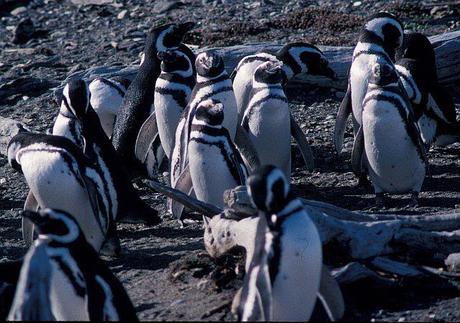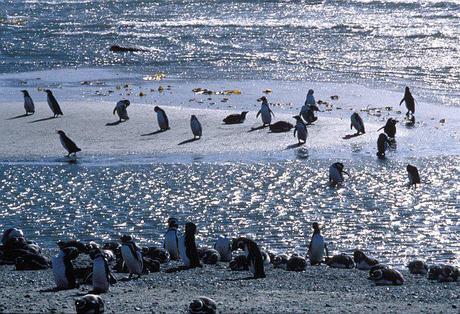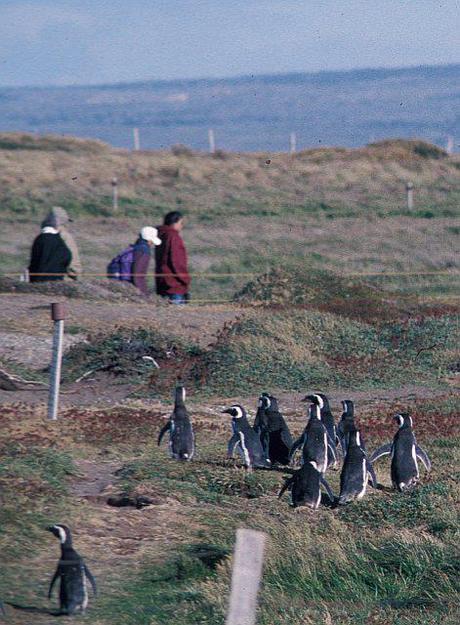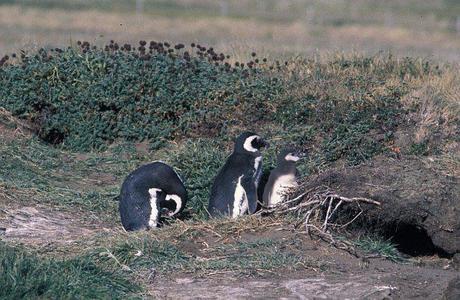
The Otway Sound in southern Chile is the summer home of thousands of Magellanic penguins. These "warm weather" penguins are recognized by white rings around the face and chest.
Penguins were everywhere. Some rested on the beach, cleaning themselves after a day at sea. Others marched like teams of tuxedoed soldiers across the short grass. Parent penguins and their chicks peeked out of their underground burrows. We were in southern Chile visiting a nesting colony of Magellanic penguins at the edge of the Otway Sound (Seno Otway) on the Magellan Strait. Each spring more than 1000 of these plump seabirds come ashore to this windswept plain to mate, lay eggs, and bring up their young. Although we were bundled in warm coats to protect us from the chilly wind, the penguins seemed to be enjoying the long hours of summer sunshine.On the Beach

Penguins rest on shore after spending the day at sea.
As we watched the penguins waddle across the grass they reminded us of comical waiters. Unruffled by the constant winds that sweep across the southern tip of South America, penguins are well equipped to withstand the harsh weather of this region. Luckily for us, the weather on the day we visited was mild and sunny. Because we were so far south and it was near the summer solstice, the sun remained high into the sky until well into the evening.In front of beach, a platform and blind allowed us to watch the penguins as they returned to their nests after a day catching fish. After the penguins came ashore they held out their wings, puffed up their chests, and called out with loud, braying honks. We found out why they are sometimes called jackass penguins. They sounded just like donkeys!
Don't Touch the Penguins!
Obeying the sign that warned us not to touch the penguins, we followed the winding path through the colony. A fence separated us from the nesting area. The birds paid little attention to us and went about their business cleaning their nests, tending their chicks, or making their way to and from the water.

Magellanic penguins stand about two feet tall and weigh about seven pounds. They live along the coasts of Chile, Argentina and the Falkland Islands. They are named after the explorer, Ferdinand Magellan, who saw them on his historic trip around the world between 1519 and 1522.
The Southern Hemisphere spring begins in September and that is when the penguins begin to arrive at their nesting colonies. Waddling up the shore on sturdy webbed feet, the penguins search for good nest sites. Either digging a new burrow or reusing an old one, they bring in grass and other nesting material before laying eggs.Penguin Chicks
For six weeks the penguin parents take turns sitting on the eggs to keep them warm and moist. Young penguins stay in the burrow until they are about a month and a half old. As we walked through the colony we could see some of the young birds peering cautiously out of their nest holes. Others stood by the entrance with their parents.

Penguin parents and their fluffy chick stand outside their burrow, preening their feathers to keep them smooth and clean.
Penguin parents watch over their chicks closely. They have to protect them from foxes, large seabirds, and other animals that might harm them. We watched a Patagonian fox, or zorro, scavenging an eel along the shore. No doubt, the fox would go after a penguin if the opportunity presented itself.By the time young penguins are eight weeks old they are completely covered with smooth, oily feathers and ready to join their parents in the water. They are at home in the frigid waters of the southern oceans. Tightly packed feathers keep their bodies dry, and a layer of fat under the skin helps keep them warm.
A Memorable Visit
We visited the penguin colony in December when it was bustling with activity. But, by March, all the penguins would go back to sea for the winter. Then all would be quiet on the shores of Otway Sound until the next nesting season. We were lucky to visit during the few months that the penguins spend on land.
Getting there: We flew from Santiago to Punta Arenas. After renting our vehicle (a small Toyota truck) at the airport, we headed south toward Punta Arenas, stopping at the Otway Sound penguin colony on our way. Following a sign on the highway, we bumped over a narrow dirt road for about ten miles to get to the colony. The visit to the penguin colony was a side trip to the main reason we had flown to the southern tip of Chile--a trip to Torres Del Paine National Park.
Penguins at the Zoo: You don't have to go to South America to see a breeding colony of Magellanic penguins. The San Francisco Zoo has one, with fluffy chicks appearing outside nest holes every spring. I wrote about these penguins in my children's book Penguin (Morrow Junior Books, 1988), illustrated with photos by Richard Hewett. They inspired our stop at the colony in Chile. The book is long out of print, but you may be able to find it at your library.
